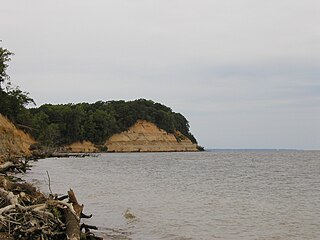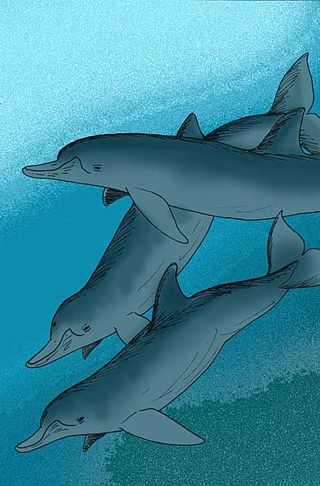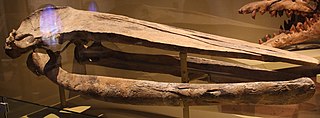
Calvert Cliffs State Park is a public recreation area in Lusby, Calvert County, Maryland, that protects a portion of the cliffs that extend for 24 miles along the eastern flank of the Calvert Peninsula on the west side of Chesapeake Bay from Chesapeake Beach southward to Drum Point. The state park is known for the abundance of mainly Middle Miocene sub-epoch fossils that can be found on the shoreline.

Squalodon is an extinct genus of whales of the Oligocene and Miocene epochs, belonging to the family Squalodontidae. Named by Jean-Pierre Sylvestre de Grateloup in 1840, it was originally believed to be an iguanodontid dinosaur but has since been reclassified. The name Squalodon comes from Squalus, a genus of shark. As a result, its name means "shark tooth". Its closest modern relative is the South Asian river dolphin.

Eurhinodelphis is an extinct genus of Miocene cetacean. Its fossils have been found in Belgium, France, and Maryland.
Kentriodon is an extinct genus of toothed whale related to modern-day dolphins. Fossils have been found in North America, Europe and Japan. Several species have been described.

Australodelphis mirus is an extinct Pliocene dolphin. A. mirus is known from fossils found in the Sørsdal Formation, Mule Peninsula, Vestfold Hills, East Antarctica. The genus has been described as an example of convergent evolution with beaked whales.

Parietobalaena is an extinct genus of baleen whale, belonging to the family Pelocetidae. Fossils are found in Miocene-aged marine strata in North America, Europe, Australia, and Japan, including the Temblor and Itahashi formations. Based on previous estimates of juvenile specimens, Tsai (2017) suggested a body size of 12-15 m for P. yamaokai, akin to that of the gray whale.

Aglaocetus is a genus of extinct baleen whales known from the Miocene of Patagonia, the US Eastern Seaboard, Japan and the Low Countries. It was once considered a member of Cetotheriidae along with many other putative cetotheres, but was recently recognized as representing a distinct family from true Cetotheriidae.
The St. Marys Formation is a geologic formation in Maryland and Virginia, United States. It preserves fossils dating back to the Miocene Epoch of the Neogene period. It is the youngest Miocene formation present in the Calvert Cliffs and is part of the Chesapeake Group.
Macrokentriodon is an extinct genus of giant dolphin once assigned to the paraphyletic/polyphyletic family Kentriodontidae. Remains have been found in the late Miocene (Serravallian) Choptank Formation of United States.
Liolithax is an extinct genus of dolphin from the Middle Miocene (Serravallian) Temblor Formation of California.

Lophocetus is an extinct genus of dolphin belonging to the clade Delphinida that is known from late Miocene (Tortonian) marine deposits in California and Maryland. Although usually placed in Kentriodontidae, recent studies have found it only distantly related to Kentriodon.
Hadrodelphis is an extinct genus of dolphin once assigned to the paraphyletic/polyphyletic family Kentriodontidae. Remains have been found in the middle Miocene (Langhian) Calvert Formation of United States.
Phocageneus is an extinct genus of river dolphin belonging to Squalodelphinidae. Specimens have been found in the middle Miocene Calvert Formation of Maryland and Virginia.

Alopias grandis is a species of giant thresher shark from the Miocene. Estimates calculated from teeth comparisons suggest the living animal was comparable in size to the extant great white shark. Remains generally consist of teeth, which have been found in the United States in the Calvert Formation of Virginia and Maryland, and in Beaufort County, South Carolina. They have also been found in the Miocene of Malta. It is unlikely it possessed the elongated tail lobe of modern thresher sharks. Some specimens in the Burdigalian show the beginnings of serrations, which are presumably transitional individuals between A. grandis and A.palatasi.

Alopias palatasi, commonly referred to as the serrated giant thresher, is an extinct species of giant thresher shark that lived approximately 20.44 to 13.7 million years ago during the Miocene epoch, and is known for its uniquely serrated teeth. It is only known from such isolated teeth, which are large and can measure up to an excess of 4 centimetres (2 in), equating to a size rivaling the great white shark, but are rare and found in deposits in the East Coast of the United States and Malta. Teeth of A. palatasi are strikingly similar to those of the giant thresher Alopias grandis, and the former has been considered as a variant of the latter in the past. Scientists hypothesized that A. palatasi may have had attained lengths comparable with the great white shark and a body outline similar to it.

The Calvert Formation is a geologic formation in Maryland, Virginia, and Delaware. It preserves fossils dating back to the early to middle Miocene epoch of the Neogene period. It is one of the three formations which make up the Calvert Cliffs, all of which are part of the Chesapeake Group.
Stenasodelphis is an extinct genus of pontoporiid dolphin from the mid-late Miocene epoch. Its name roughly translates to "the narrow-nosed dolphin." The genus is currently monotypic, containing only the species S. russellae. The specific epithet honors Mrs. Jean Hopper, who discovered the holotype. It was found in material derived from zone 22-23 of St. Marys Formation, which dates to the early Tortonian.

Messapicetus is an extinct genus of beaked whale from the Late Miocene. It currently holds two species, M. longirostris from the Tortonian of Italy and M. gregarius from the Pisco Formation of Peru. However, a third unnamed species is represented in the St. Marys Formation of Maryland known from fragmentary material. M. gregarius is sexually dimorphic, males having tusks which are hypothesized to have been used in intraspecific combat for mates as in extant (living) beaked whales.

Atlanticetus is a genus of extinct baleen whales known from the Early Miocene of Italy and the US Eastern Seaboard.
Palaealectoris is an extinct monotypic genus of landfowl, belonging to the family Tetraonidae, distantly related with modern grouses. Its fossilized remains, found in the Marsland Formation, a part of the Agate Fossil Beds National Monument in Nebraska, and in the Calvert Formation in Maryland, are dated from the Early Miocene.











